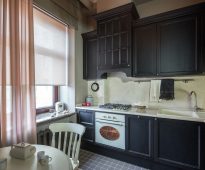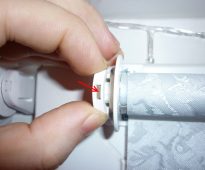 How to choose blinds for the kitchen on plastic windows
How to choose blinds for the kitchen on plastic windows
Types of decorative curtains on interior doors
The times when curtains performed only one, although very important, protective function have sunk into oblivion. Today, curtains are used to decorate and complement the design solutions in the interior.
Any interior will look more comfortable if there are curtains in its design.
Content
Curtains for the design of doorways
Curtains on the doorway - the idea is not new. Our ancestors, for example, “creatively” made out the entrance to their own dwelling with the skins of animals. It is a functional solution.
When interior design, you can use curtains on the doorway.
Today doorways are decorated with curtains of various shapes and materials mainly for aesthetic purposes. I want to arrange the room in an unusual and convenient way.
Curtains can be used not only for window openings, but also for zoning space.
It is worth noting that the curtains on the doorway is a solution that is suitable for almost any style, the main thing is to choose the right material and shape of the structure. Curtains on the door or doorway will not provide good sound insulation, and will not be reliable protection from light or other people's views, but, as a rule, this is not required of them.
Designers can apply this design method in both classic and modern design styles.
The following products are used as materials for such curtains.
- Bamboo or jute.
Different combinations used in different rooms of the same house will allow you to create a strict style in some rooms, and a soft, relaxing environment in others.
By themselves, these materials do not differ exquisite appearance, but properly chosen form of curtains allows you to make the room very cozy and comfortable for intimate gatherings.
- Fabrics
There is a place for imagination.
First, the diversity of the options offered is truly amazing. Choose the right texture based on your own preferences, interior decoration or furniture upholstery. In addition, the fabric allows you to make a design of almost any size and shape, which means you are guaranteed to be able to make your own dream a reality.
- Plastic.
Appearing relatively recently, this material managed to gain universal popularity.
Perhaps there was no sphere in which plastic would not have found application. And doorways are no exception.
- Rope.
A universal option for packaging anything finds a new life in design projects.
Thanks to the strength and flexibility, creative models of curtains are created from cords, allowing the most ordinary interior to look individual.
Door curtains are used where insulation is not required.
In rare cases, it is necessary to hide the presence of doors. This is because the doors do not fit into the overall design solution. Then the canvas is attached directly to the door. And, while in the room, you can not even immediately determine what the interroom door hides behind a beautifully draped curtain.For such purposes, more often use volumetric designs with ruffles and frills, from the material chosen to match the general decoration of the walls or upholstery of upholstered furniture.
"Door" curtain simply must be combined with the window.
Important! Special attention should be paid to the fastening of the canvas, both on the door itself and on the doorway. Take care of a reliable option, because the doors will constantly open and close, and the design may not withstand.
Often, decorative curtains are used for zoning the space of impressive size, to obtain more secluded corners in a large room.
Sometimes with the help of decorative elements divide the living room and dining room.
Types of decorative curtains
Plastic
Plastic products are valued for durability, practicality, ease of operation, as well as for water resistance. It is not surprising that “portieres” of such material are used in different rooms and structures: in gazebos, on terraces, in bathrooms, in the kitchen space, and also in industrial premises - in warehouses and car washes.
Usually use plastic with a smooth surface, monophonic or with colored inserts, less often used corrugated analog.
Unlike other materials, plastic is a very practical material, therefore, in addition to the decorative function, it also copes with protection from rain and wind, with preservation of heat in the room and has good translucency.
The design of plastic "portieres" is diverse.
Someone prefers the classic version of canvases moving along the eaves, to someone more like a model that is going to roll.
Choose depending on personal preferences and room parameters.
Wood
It is difficult to find a more eco-friendly and pleasant material than wood. It is not surprising that he is so in demand in different areas and areas of our life. And wooden curtains for doors is a work of art, which besides its main task - zoning of space - copes well with the aesthetic function - to delight and delight.
Visibility of isolation and free movement through them will be a good solution for the living room or dining room, as well as in other rooms that do not require isolation from easy access.
Small pieces of wood strung on a strong cord in a certain order can surprise. Available in different color variations, there are plain curtains or contrasting. Pieces of wood of the simplest form (cubes, circles) or true mini masterpieces.
A similar element of the interior is combined with additional wooden objects in the room: statuettes, lamps or shelves.
For doorways, compositions can be used in which the doorway does not close, and the curtains form a decorative component of the interior.
Along with the visual appeal and exclusivity, these curtains have several disadvantages.
- Can seriously complicate the passage from one room to another.
- Difficult to care for. Dust accumulates on small elements, and it is very difficult to wash such curtains: the tree expands from water and the color suffers.
- Wooden curtains - a noisy element of the interior, which can also be annoying.
By itself, the design is quite heavy, which means that just hanging on a carnation is not an option. Use a special eaves, which will not "argue" with a common interior solution and will ensure the safety of you, your household and pets.
It is important to consider fixing such decorative curtains.
In addition, even if the design of decorative curtains for the door you liked in the store, not the fact that it fits perfectly into the interior. Only one rule: the room should not be all wooden: wall, floor decoration, furniture of natural color, as well as window blinds and curtains for doorways. In this case, you risk losing the highlight that wooden decor gives the interior.
Curtains when closing and opening the door should not interfere, so the edges of the door can be installed additional mount.
Of beads
It cannot be said that such interior curtains are the most popular option, but craftswomen often use them in the interior. Moreover, today beads are available in a large assortment.
Create your interior masterpiece is not difficult.
Most often, these "curtains" are used to zoning space in the bedroom or nursery, or to separate the bay window from the main part of the room. Properly selected beads and the shape of the structure are really capable of making the room comfortable and pleasant for spending time.
Due to this, an atmosphere of comfort and airiness of the room is created.
Cotton
The eastern element of the interior has firmly entered our daily life and helps to make it spectacular. Cotton curtains are used for a long time. They are appropriate as a standard window opening design, suitable for zoning space and able to decorate any doorway. By the way, such a model can be created with your own hands. It does not require serious financial investments, and with minimal time and effort, you can make your own exclusive interior element.
The shape and mounting options used are different.
Curtains-harmonicas
An interesting know-how that has found recognition. They are made of different materials: glass, plastic, wood or paper. Used in different rooms. For example, a plastic accordion curtain in the bathroom will protect the room from excess water. And paper curtains with an accordion on the windows (plisse) will reliably protect from excess light and will eliminate the need to use three-dimensional structures.
Wooden interior accordions will save space and make the room more functional.
Curtains for interior doors do it yourself
If you are a supporter of the classic version, then you can sew curtains with your own hands from fabric.
Creating a decorative effect, you can additionally control the light transmission of the door.
This will require:
- scissors, centimeter, pins;
- sewing machine;
- special braid;
- the cloth.
Important! Choosing a simple design of curtains for interior doors, you can "win" at the expense of spectacular fabric.
Novice needlewomen better to opt for a simple model: two separate curtains, freely sliding on the bottom. You will need to take two measurements: length and width. To the canvas were voluminous, the width of the doorway is multiplied by 2. We choose the length at will.
As a rule, to the floor should be 5 - 10 cm.
First we process the sides of the canvases. Then run the line on the bottom. And we sew a special band to the upper part, thanks to which the canvas will hold the required volume. At the last stage, we fasten the curtains to the eaves and place the eaves above the door.
To make your home beautiful is a matter for everyone.
With a little imagination, the standard doorway can be turned into a real gem of the interior.
VIDEO: Interior curtains.
50 options for interior curtains in the interior:
 How to choose blinds for the kitchen on plastic windows
How to choose blinds for the kitchen on plastic windows
 Step by step instructions on how to assemble roller blinds.
Step by step instructions on how to assemble roller blinds.






